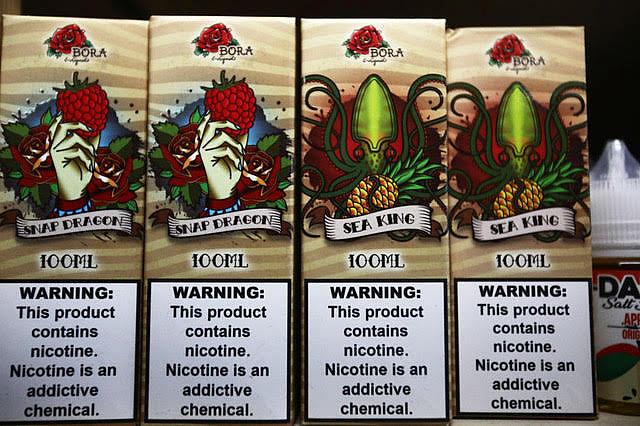What’s the e-cigarette ingredient to really fear? Nicotine

Photo credit: (Photo by Mario Tama/Getty Images)
There’s a rush to ban a dangerous ingredient in some e-cigarette products.
But people are missing the truly deadly ingredient in these electronic drug-delivery devices: nicotine.
Let me back up. You may have seen the news about the thousands of people getting sick and injured from e-cigarettes this year. At least 34 people have died. Now the blame is being placed on vitamin E acetate, an ingredient used to make marijuana capsules that can be smoked with e-cigarettes. Some regulatory agencies responded by banning the use of vitamin e acetate in marijuana products. And cannabis companies responded by putting the blame on companies making e-cigarette products outside of regulatory scrutiny.
Meanwhile, nicotine remains the key ingredient inside these e-cigarette products that makes them such hot sellers, especially among young people. The American Lung Association puts it bluntly:
Research suggests that nicotine is as addictive as heroin, cocaine, or alcohol. That's one of the reasons it's so hard to quit. Nicotine is not safe.
It’s worth repeating: Nicotine is not safe.
The National Institutes of Health on its SmokeFree.gov site says:
E-cigarettes are harmful for youth, young adults, and pregnant women. The nicotine in e-cigarettes is harmful for developing babies, and can lead to addiction and harm brain development in children and young adults into their early 20s.
So while you are writing about vitamin E acetate or other relatively unknown ingredients that may be contributing to the sudden spike in deaths and injuries among e-cigarette users, spend a little time also writing about nicotine, which, by way of tobacco products, contributes every year to the loss of 10 million healthy years of life in the United States and 182 million healthy years of life globally.
Nicotine gets you hooked on smoking. And deaths from smoking now number 7 million globally, with the number going up every year.
Personal injury attorneys are onto this, so much so that when I was doing research for this post, I received a popup add from Martindale-Avvo, the legal services giant, that said, “The use of Juul or e-cigarettes can lead to injury or nicotine addiction. Connect with an attorney and get a FREE consultation now!”
You should get interested, too. Nicotine addiction is the pathway for a host of other bad things that follow. Matt McMillen wrote a great piece for WebMD that described some of the garbage that people are sucking into their systems from e-cigarettes. Then, once addicted to nicotine, people expose themselves to a toxic stew of pollutants from regular cigarettes.
The addictive ingredient in e-cigarettes and regular cigarettes, nicotine stimulates the central nervous system and raises blood pressure, respiration, and heart rate. “People smoke because of the nicotine,” says researcher Maciej Goniewicz, PhD, PharmD. He's a tobacco and e-cigarette expert at the Roswell Park Cancer Institute in Buffalo, N.Y. While it's addictive, nicotine doesn't cause cancer, says Goniewicz: “What causes concern are the other chemicals (in the e-liquid).”
Here's one way to tackle this story: Find a local school on an online map. Then do a search nearby for stores. Chances are good that you will find all kinds of places selling e-cigarette products.
Juul, the top e-cigarette brand, makes it easy for you by allowing you to plug in your address and find places that sell Juul nearby. On the Juul site alone I found 11 stores within 1 mile of an elementary school near me that sell e-cigarette products. I found another five just by driving in the vicinity.
Go into the stores and check out the brands at the store. How many include nicotine? What other sketchy sounding ingredients are on the list? Here are just a few to look for:
-
Formaldehyde: linked to cancer
-
Acetaldehyde: linked to cancer
-
Acrolein: linked to lung damage
-
Lead: linked to cancer and heart disease
Then there are the hundreds of different flavorings being added to these e-cigarette cartridges. Researchers at the University of Northern California tested the flavorings and other ingredients on human cells and found that some of them were toxic to human cells.
“They found that these ingredients varied tremendously across the e-liquid products tested, and on the whole, more ingredients meant greater toxicity,” the school said in a press release.
Some of the names of these flavorings sound like they were created by Stan Lee, with names like “vanillin” or, if that’s too subtly sinister for you, try out “cinnamaldehyde.” Woah, not in my lungs, please.
"The higher the concentrations of these compounds in particular, the more toxic the e-liquids were," researcher Flori Sassano said in the press release.
Some of these chemicals won’t be listed on the box but will be generated as the liquid inside the e-cigarette heats up. And what’s driving people to crank up the heat? Nicotine.
“Unfortunately, the higher you heat the liquid, the more nicotine you get from it,” Goniewicz told WebMD. “People who want to get a big dose of nicotine may use really high voltage batteries or an adjustable voltage battery.”
After you check out where e-cigarette products are being sold and with what ingredients, talk with people you find buying these products in the store. Ask them if they knew they contained nicotine. Ask them if they felt any compulsion to keep smoking them once they started. Ask them if they have any other noticeable health effects.
These are the things the personal injury lawyers want to know, too. So, instead of waiting for the results of a big class action lawsuit, which is sure to be in the works, get out ahead of this story today.
